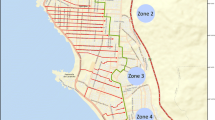Abstract
Through the experiences of the Great 1994 Hanshin-Awaji earthquake and the Great 2011 East Japan earthquake, it has been important for local governments to build the comprehensive evacuation program on a large earthquake occurrence in near future. According to the experts’ forecast, huge earthquakes will occur around the coast areas of Pacific Ocean in Japan in near future. Therefore, it is indispensable to give appropriate information and knowledge on human behavior for the evacuation time. It is also necessary to urge the residents to select rational behaviors. Therefore, a new methodology based on behavior-oriented agent system should be developed to show our community activities. In this study, the production rules of each agent were constructed due to the expected activities based on the questionnaire survey. Next, by using the set of production rules composed of such data, multi-agent system models were built for analyses on both the evacuative behavior and the behavior of return trips to home during a hypothetical large-scaled earthquake. The simulations were tried by using specific data including those of the Person Trip Survey. It comes to the conclusion that the human behaviors during the earthquake were simulated by multi-agent system model and as a result, the appropriate evacuation method was discussed and the possibility of the return home was found in view of the conditions of the roads and the human attributes.
Access this chapter
Tax calculation will be finalised at checkout
Purchases are for personal use only
Similar content being viewed by others
References
Batty M (2001) Exploring Isovist fields: space and shape in architectural and urban morphology. Environ Plann B 28:123–150
Batty M (2003) Agent-based pedestrian modeling. In: Advanced spatial analysis. ESRI Press, Redlands
Ferber J (1999) Multi-agent systems, an introduction to distributed artificial intelligence. Addison-Wesley, Boston
Horvitz EL, Breese JS, Henrion M (1988) Decision theory in expert systems and artificial intelligence. Int J Approx Reason 2:247–302
Kagaya S (2010) An application of multi-agent simulation for evacuation in earthquake disaster. In: Proceedings of ICSBE, Keynote Papers, pp 3–10
Kagaya S, Shinada C (2002) An use of conjoint analysis with fuzzy regression for evaluation of alternatives of urban transportation schemes. In: The 13th mini-Euro conference, handling uncertainty in the analysis of traffic and transportation systems, pp 117–125
Kagaya S., Uchida K (2010) Development of multi-agent simulation model for evacuation from landslide disaster area. In: Proceedings of the 49th congress of the ERSA, (CD-ROM), 2010
Kagaya S, Uchida K, Hagiwara T, Negishi A (2005) An application of multi-agent simulation to traffic behavior for evaluation in earthquake disaster. J East Asia Soc Transp Stud 6:4224–4236
Kagaya S, Aitsuki T, Uchida K (2007) Analysis of human behavior representation in the Central Business District of Sapporo using a multi-agent simulation. Stud Reg Sci 37(2):519–534
Kagaya S, Ishiguro U, Uchida K (2011) Multi-agent simulation to uncertain civilian return trips during a hypothetical earthquake. In: Proceedings of the ICVRAM 2011 & ISUMA 2011, pp 104–112
Negishi A, Kagaya S, Uchida K, Hagiwara T(2004) A study on application of rule base by considering earthquake experience to seismic evacuation simulation. In: Proceeding in infrastructure planning, JSCE (in Japanese)
Russell S, Norvig P (1995) Artificial intelligence, a modern approach. Prentice Hall, Englewood
Ulieru M, Norrie D (2000) Fault recovery in distributed manufacturing systems by emergent holonie re-configuration, a fuzzy multi-agent modeling approach. Inf Sci 7669:101–125
Wilson SW (1991) Knowledge growth in an artificial animal. In: First international conference on genetic algorithms and their applications. Carnegie-Mellon University, Pittsburgh, pp 16–23
Yamakage S, Hattori S (2002) Artificial Society in the computer. Kyoritsu-shuppan (in Japanese)
Acknowledgement
The author is grateful to Prof. Toru Hagiwara and Prof. Kenetsu Uchida in Hokkaido university for helpful discussions. The author wishes to acknowledge Dr. Katia Andrade for her help in interpreting the significance of the results of this study. The author also gratefully acknowledges the work of past members of the laboratory, Ms. Ishiguro, Mr. Negishi, Mr. Sasaki et al. in Hokkaido university.
Finally the author writes down that there was the quotation from the existing paper in Journal of the EASTS, the reference described below (Kagaya et al. 2005) about this paper partly.
Author information
Authors and Affiliations
Corresponding author
Editor information
Editors and Affiliations
Rights and permissions
Copyright information
© 2022 Springer Nature Singapore Pte Ltd.
About this chapter
Cite this chapter
Kagaya, S. (2022). Multi-Agent Simulation for Prediction of Human Behavior During a Hypothetical Earthquake. In: Higano, Y., Kiminami, L., Ishibashi, K. (eds) New Frontiers of Policy Evaluation in Regional Science. New Frontiers in Regional Science: Asian Perspectives, vol 52. Springer, Singapore. https://doi.org/10.1007/978-981-16-4501-3_11
Download citation
DOI: https://doi.org/10.1007/978-981-16-4501-3_11
Published:
Publisher Name: Springer, Singapore
Print ISBN: 978-981-16-4500-6
Online ISBN: 978-981-16-4501-3
eBook Packages: Economics and FinanceEconomics and Finance (R0)




